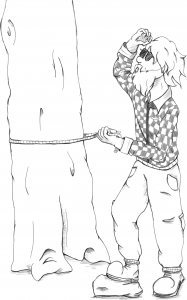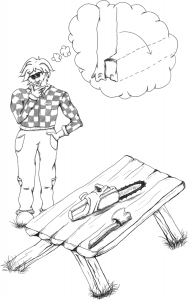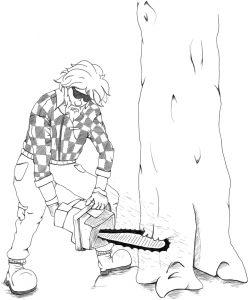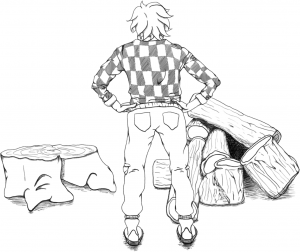Part I. PROBLEM SOLVING
2. Problem Solving as a Process
Problem Solving as a Process
What is a problem?
Let’s establish this right away: a problem is an intellectual challenge. Solving a problem is then a process of undertaking and overcoming the challenge.
As we have indicated elsewhere, authentic problems are often poorly-structured and vague. They are not carefully-crafted to yield whole-number answers with a few minutes of symbolic manipulation, like those you typically encounter in school. Authentic problems could take hours, days, or even longer to solve, and you may not always know with confidence that you have succeeded because the answers aren’t in the back of the book. Problems don’t require only the application of a recently-learned method or algorithm; indeed, you may not know at the outset which methods are appropriate for solving the problem. You may not be given all the information needed to achieve a complete solution, or information you are given may be uncertain or incomplete. In short, authentic problems are hard, and that can be frustrating.
But wait! Don’t close your book (or laptop) and walk away just yet! Having just explained the difficulties, consider the flip side of the problem-solving coin: problems that are authentic are also inherently interesting, particularly when they address contemporary issues or puzzles in your chosen area of study. Solutions and solution methods for such problems are therefore not just an academic dead-end, but can lend themselves to practical applications in the real world. The rewards of achieving a clever and well-justified solution to a practical and interesting problem should outweigh by far the moments of uncertainty, frustration, or disappointment encountered along the way.
Most of the problems discussed in this book are designed to mimic authentic problems, and in many cases are drawn from or inspired by encounters with local researchers and practitioners. As we endeavor to address these problems, we’ll often find it helpful to explore simpler problems and exercises to help with sense-making. Thus, our time will be spent moving back and forth from focus problems to auxiliary problems and exercises. Read on through the end of this chapter to understand how this approach can lead to more successful problem-solving.
Problem solving cannot be reduced to a simple recipe or fast and easy method, but in the past 70 years, much has been learned about how successful construction of solutions differs from unsuccessful attempts. A key component is the use of heuristics, or habits of mind that are useful in solving problems. The modern idea of heuristics has its origin in the work of Hungarian mathematician George Pólya in the mid 20th century. Heuristics help guide us in decisions about how to approach a problem. With the help of heuristics and the benefit of experience, we may develop problem-solving strategies that lead to successful solutions. We’ll begin our study of problem-solving with a brief look at Pólya’s method and some of his heuristics and then consider how they might apply to problem-solving in the natural science and natural resource management contexts.

Pólya’s method and beyond
A credentialed mathematician and academic, Pólya was no stranger to the struggles of solving difficult problems. But he was also a teacher and concerned himself with the development of problem-solving skill and intuition in students. He studied his own problem-solving process and that of his professional colleagues and distilled his observations into four essential principles. These principles are general–that is, their use needn’t be limited to mathematical problem-solving. The method can be summarized as follows:
Pólya’s Method, Condensed and Slightly Revised
- Understand the problem. What is the unknown or target quantity? Is there enough information to find a solution? How is the information that is available relevant to the unknown?
- Plan a solution strategy. How can you proceed from the information available to the unknown? What steps are necessary, and how will the given information be used?
- Execute the solution plan. If the solution plan is chosen well, the implementation of the plan should yield the sought-after result. If insurmountable difficulty arises, an alternative plan may need to be formulated.
- Check the result. Does the result satisfy the conditions stated in the problem? Is it consistent with expectations or within reasonable bounds? Can you arrive at the same result using a different approach?
These principles may seem obvious, but when the time comes to actually solve a problem it is easy to overlook one or more of them or to lose track of what we are after. Employing this method as a general framework for approaching problem-solving will yield more consistent success and more reliable results.

Consider the most common words out of a typical college student’s mouth when confronted with a novel problem: “I don’t know where to start”. Perhaps the student really means “you haven’t yet told me exactly what to do to get the answer”. But if the instructor were to point the student toward a solution method every time she was confronted with a challenging problem, she would learn only two things: 1) how to implement algorithms and compute numerical results as instructed; and 2) to relinquish all control of choosing how to approach and solve a problem to somebody else. Sadly, this is often the best outcome of the standard school mathematics curriculum. The worst outcome is that students dismiss math as boring, difficult, or irrelevant. In some cases, a diligent student develops some facility1 with basic manipulations of mathematical symbols and numbers, but little or no ability to create the frame of mind and methodological structure needed to begin and confidently proceed trying solutions.
For the challenge of getting started, Pólya’s framework offers Understand. What is the problem really asking, and what exactly do you want to end up with as a result? Take, for instance, the pheasant count problem that we introduced in the first chapter: what is the unknown in that problem? Essentially, the question we posed there was how many pheasants we should expect to be living in Iowa in the next few years. In some ways, this is a specific reinterpretation of the problem statement, but the simple act of making that re-interpretation not only helps us understand what we are looking for concretely, but our formal statement of it might clarify to colleagues or readers what our solution is driving at.

Since Pólya’s framework was developed from the perspective of a mathematician, some of the questions and suggestions pertain mostly to abstract problems. The framework doesn’t take advantage of the fact that most of our problems are situated in real-world contexts and involve quantities whose properties can be used as an asset in identifying, constructing, and evaluating solutions. If you’re not exactly clear on what I mean by that, go ahead and peek at the next chapter where we discuss the definition and properties of quantities.

Below, I have expanded and elaborated upon Pólya’s framework and adapted some of the details for problem-solving in natural sciences.
Solving Ill-structured Problems
- Understand the problem
- Do you understand the problem as it is stated?
- Can you restate the problem in your own words?
- What is the unknown or desired quantity or output (be specific)? Is it a number? A function? A procedure?
- Can you make a drawing or diagram to illustrate how the unknown relates to any known quantities or to the broader problem-space?
- Do you already know approximately what the value should be? Can you guess a ballpark or range of reasonable values?
- How accurate does your solution need to be? What are the consequences of errors?
- What information do you already have?
- Is the information that you already have sufficient to solve the problem?
- If appropriate, can you write the problem as an algebraic equation with suitable notation?
- Plan a solution. Consider multiple approaches if possible.
- Have you successfully solved a problem like this before?
- Has somebody else documented a solution method to this or a similar problem?
- If the problem can be written explicitly as a mathematical statement, do you recognize an algorithm or heuristic that can yield the desired unknown?
- If a solution method is apparent, can you assemble all the needed quantities?
- If the problem is not immediately solvable, or a solution method not yet apparent…
- Can you break the problem into smaller sub-problems that may be easier to solve?
- Can you approximate uncertain or unknown quantities
- Could you solve a related auxiliary problem to gain insight?
- If data are given, what exploratory analyses could be done to spark ideas?
- Execute the plan
- At each step, check to see if the incremental result matches expectations.
- Double-check all formulae and algebraic manipulations.
- If appropriate, is unit/dimensional homogeneity satisfied?
- If you encounter difficulties, revisit the plan and alternatives.
- Check the solution
- Is the result reasonable?
- Is it consistent with ballpark estimates or benchmarks?
- If appropriate, can you substitute the result into the original problem and satisfy the assumptions and conditions?
- Double-check algebraic manipulations.
- Double-check numerical computations.
- Could you document your full solution with a concise but complete summary of steps, justification of assumptions and methods?
- Could a colleague reproduce your approach and find the same solution?
Pólya’s framework, and our elaboration of it for problems in the natural sciences, may help us be better organized, but when it comes to applying the quantitative skills we spent years developing in math and statistics classes, we still have little guidance. In Pólya’s How to Solve It, this is the point where the idea and utility of heuristics was introduced. In the next section, we will introduce and review some generic heuristics that can aid with understanding the problem and inspiring a solution plan.
A Few Versatile Heuristics
The heuristics we consider here are just a snapshot of the generic methods we might employ in many problems, and some of these are further elaborated in subsequent chapters. These should be some of your most frequent go-to tools for the initial understanding and planning phases, and can be interpreted differently according to the constraints or conditions of each problem. In selecting optimal strategies, the field of options may be narrowed by examining the nature of the unknown. Think about the unknown and what it represents, not only for the focus problem but for any sub-problems or for any goals identified as necessary to solving the focus problem. Could the problem be stated in the form “how much…?”, “how many…?”, or “is…or not?”. If so, the problem might require arithmetic and/or algebraic reasoning. If data is available or supplied and the problem can be stated in the form “what relationship…?” or “how does…change as you vary…?”, graphical and statistical reasoning are probably appropriate. If the problem can be stated in the form “how big…?”, “what distance…?” or “where…?”, then geometric or spatial reasoning could be necessary2. There are certainly problems that won’t be easily stated in any of these terms, and all options should then remain open. Nevertheless, recognizing common properties in the nature of problems can sometimes narrow down your choices of strategies and make promising solution methods or approaches more apparent.
- Break the problem into sub-problems. Complex problems often require multiple steps that can be divided into discrete sub-goals. For example, determining the value of an unknown quantity that is required to solve the focus problem can be considered distinct from solving the focus problem itself. Therefore mapping out the solution in terms of incremental sub-goals can clarify the pathway to a solution.
- Express conditions algebraically. Assign symbols to relevant quantities and express the relationship, if known, as an equation relating the quantities. If relationships are not known beforehand, use dimensional analysis to suggest them.
- Guess the correct answer or solution. Usually a guess or ball-park estimate is not sufficient if the issue is truly a problem, but estimates can still be used to help you recognize if you are on the right track in later computations. If you know approximately what the solution is or what range it should lie within, use this value to check your work. If the solution is not known beforehand but algebraic or practical constraints are available on related quantities, use those quantities to get a ballpark estimate. At this stage, back-of-the-envelope calculations in scientific notation can make quick work of it.
- Try a few values. Where some values are unknown but are not the desired quantity, try to solve the problem with a few supposed numerical values. Sometimes the outcome of algebraic relationships is relatively insensitive to the precise value of the quantities included in the relationship. When the relationship is strongly sensitive to unknown or poorly-constrained quantities, identify those quantities as important intermediate goals or sub-problems.
- Draw a picture or diagram. When the problem is inherently spatial, such as in the case of habitat or landscape ecology problems, make a map or schematic drawing of the geometric or spatial relationships between known and unknown quantities. To the extent that it is possible, scale distances or spatial dimensions accurately.
- List all possible cases. If you’re confronted with a logic or simple probabilistic puzzle, make a list or matrix containing possible permutations or combinations.
- Work backwards. Where the desired ending condition is known or can be approximated but the steps to reach it are not known, use the end result to help “back out” the steps.
- Visualize the data. If data or input values are given and a relationship or summary-statistic is desired, make a graph or diagram from the data. In some cases, visual representation of the data can suggest or substantiate approximate values for the unknowns or can illustrate the form of functional relationships.
- Solve a simpler problem. Sometimes a condition or relationship is too complex to solve easily in its full form. In these cases, it may be possible and helpful to simplify the condition to make the problem tractable. You can do this by assuming that an unknown value is known (as in Try a few values), by eliminating one or more terms in sums and differences, or by using a simpler statement of the original condition.
The heuristics above are by no means a recipe for success in every situation, but they should be available to you in your repertoire of things to consider. In the chapters that follow, we will elaborate on some of these strategies and add more context-specific tools that can be applied in practical problems.
Stepping back
Before we set you loose on solving problems, it is important to address the mind-set of problem solving. If you have ever uttered the words “I suck at math” or something similar, this section is particularly for you. But as far as I’m concerned, realizing how the mind constructs knowledge and understanding in a problem-solving task is an empowering notion. Alan Schoenfeld, mathematician and math-education specialist, has identified four aspects of the mental process of problem-solving that are essential: Resources, Heuristics, Control, and Belief. Each is necessary and problem-solving cannot or will not proceed without them. First, let’s look at what each means, and then we’ll consider how they contribute to our problem-solving success.
Resources
These are the things you know or understand about the problem domain, constraints on quantities and their representation in the problem domain, and the skills you possess in performing algorithmic procedures.
Heuristics
The decision-making tools used to make sense of challenging problems that allow you to make progress or develop insight. Most of the chapters of this booklet are devoted to developing strategies useful in natural science or resource management domains.
Control
Control is the management and self-awareness of the problem-solving process. It includes planning, execution and evaluation decisions and and the selection of resources and heuristics for the problem.
Belief
Belief includes the set of notions one has about the problem domain as well as one’s own abilities or challenges in applying math and statistics to the problem domain; this also includes preconceptions and (mis)understandings that could lead to the use of (in)correct resources and heuristics in a given problem.
Your mathematics and statistics education up to this point has almost certainly stressed resources. Thus, the quantitative resources you bring to a problem consist of all the algorithms and methods you know how to use and your understanding of what they do or mean. Unless you’ve followed a curriculum through school and college that has deliberately made use of these resources, you’ve probably forgotten many of them, but re-learning them may not be as challenging as learning them naively. Control and belief are gained from experience, and can build from any foundation of resources and heuristics. The heuristics and strategies themselves can be a bit of a problem though.
You may have been instructed some in the development solution strategies in school, but there’s an important distinction between learning what to use and learning when to use it. Some people may argue that it is not a mathematician’s prerogative to instruct students in their service courses in more than resources, since heuristics vary from one discipline to another and control and belief grow with experience. This argument is fair, but as non-mathematicians we’re left with training in how to implement algorithms, but little idea about how to use those algorithms unless presented with problems that aren’t really problems but exercises.
As a result, when the going gets tough,…we get stuck. That’s where this course comes in (hopefully to the rescue??). This is your opportunity to work with resources you already have at your disposal, perhaps learn a few more, and to be introduced to strategies for using them in problems that you might encounter in other natural resource courses, in internships, or in your career. By working through these problems in a systematic manner, you’ll learn how to control your problem-solving process while building your experience base. I sincerely hope that your belief system evolves in such a way that you become confident that you can solve quantitative problems too!
Exercises
- Think of a challenging problem that you needed help to solve in one of your high school or college courses. It could be a mathematical problem, but doesn’t have to be. Describe the problem and reflect on what assistance you needed to arrive at a solution. Were you unable to get started? Did you need help with recognizing and implementing the appropriate algorithms? What was the nature of the assistance that helped you solve the problem? Was it satisfying to arrive at the correct solution?
- Now reflect on a challenging problem that you were able to solve correctly without assistance. Why were you successful? Were you able to overcome any difficulties or hurdles along the way? Was it more or less satisfying to solve this problem on your own than to solve a problem with help? Why?
- What resources do you think a person needs to be able to make good predictions of pheasant population over the coming 5 years?

